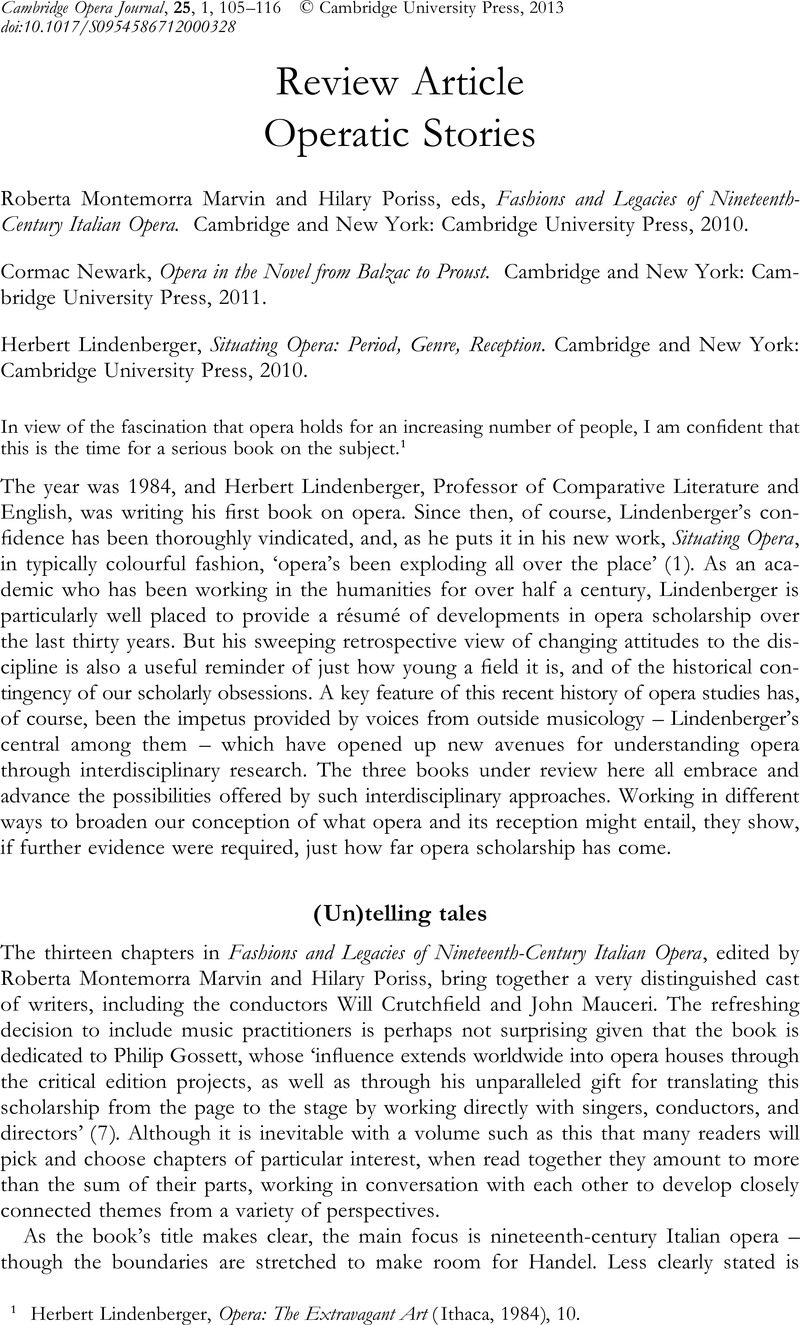No CrossRef data available.
Article contents
Abstract

- Type
- Review Article
- Information
- Copyright
- Copyright © Cambridge University Press 2013
References
1 Lindenberger, Herbert, Opera: The Extravagant Art (Ithaca, 1984), 10Google Scholar.
2 See, for example, Music, Theater, and Cultural Transfer: Paris, 1830–1914, ed. Fauser, Annegret and Everist, Mark (Chicago, 2009)CrossRefGoogle Scholar; Operatic Migrations: Transforming Works and Crossing Boundaries, ed. Marvin, Roberta Montemorra and Thomas, Downing A. (Aldershot, 2006)Google Scholar; and The Arts of the Prima Donna in the Long Nineteenth Century, ed. Cowgill, Rachel and Poriss, Hilary (Oxford, 2012)CrossRefGoogle Scholar. It should come as no surprise that at least four of the authors featured in Fashions and Legacies have also contributed to these similarly themed volumes.
3 Goehr, Lydia's seminal The Imaginary Museum of Musical Works (Oxford, 1992)Google Scholar largely leaves operatic works out of the argument; more recent discussions that address this gap include Parker, Roger, Remaking the Song: Operatic Visions and Revisions from Handel to Berio (Berkeley and Los Angeles, 2006)CrossRefGoogle Scholar, particularly Chapter 1, and Rachel Cowgill, ‘Mozart Productions and the Emergence of Werktreue at London's Italian Opera House, 1780–1830’, in Operatic Migrations, 145–86.
4 Parker, Remaking the Song, 8.
5 On changing attitudes towards seeing and listening in nineteenth-century France, see Jay, Martin, Downcast Eyes: The Denigration of Vision in Twentieth-Century French Thought (Berkeley and Los Angeles, 1993), 83–209Google Scholar; Johnson, James H., Listening in Paris: A Cultural History (Berkeley and Los Angeles, 1995)Google Scholar; and Cooper, Jeffrey, The Rise of Instrumental Music and Concert Series in Paris, 1828–1871 (Ann Arbor, 1983)Google Scholar. Newark also observes that this shift from an emphasis on opera to instrumental music was eventually mirrored in novels; see Opera and the Novel, 199.
6 Locke, Ralph P., ‘Aida and nine readings of empire’, Nineteenth-Century Music Review, 3 (2006), 45–72CrossRefGoogle Scholar.
7 The practice of treating the high B at the end of ‘Nessun Dorma’ as a semibreve instead of a semiquaver, is cited by Crutchfield as one example of the ‘caricature tradition’ (252).
8 Parker, Remaking the Song, 8.
9 This appears to be an expansion of Lindenberger's argument that such scenes functioned in novels in order to create a contrast between the ‘higher’ narrative of opera, and the ‘lower’ narrative of the novel; see Lindenberger, Opera: The Extravagant Art, 145–96.
10 Ellis, Katharine, Interpreting the Musical Past: Early Music in Nineteenth-Century France (Oxford, 2005), xviiGoogle Scholar.
11 For the full story behind the buried cylinders, see expositions.bnf.fr/voix/index.htm.
12 See, for example, Chapter 4, ‘Opera in Novels’, in Lindenberger, Opera: The Extravagant Art, 145–96.
13 With its many references to genuine performers and events – including the burial of recordings beneath the Palais Garnier – Le Fantôme de l'Opéra is an excellent example of this practice; see Newark, 142–49.
14 See ‘Epilogue: In the Form of an Interview’, in The History in Literature: On Value, Genre, Institutions (New York, 1990), 211–20; and ‘Moses und Aron, Mahagonny, and Germany in 1930: Seventeen Entries’, in Opera in History: From Monteverdi to Cage (Stanford, 1998), 191–239.
15 This crisis-riddled production opened up a number of other fissures through which to explore the nature of operatic experience. For Alex Ross, the last-minute replacement of Heppner by Gary Lehman – singing Tristan for the first time – and the mid-performance substitution of Janice Beard for a suddenly indisposed Voigt, led to the ‘primitive thrill of the unexpected’, so often absent from opera today. See Ross, ‘Tristan and Two Isoldes: A Wild Night at the Met’, The New Yorker, 31 March 2008, 130–1.
16 Abbate, Carolyn, ‘Music – Drastic or Gnostic?’, Critical Inquiry, 30 (2004), 505–36Google Scholar, here 512. Scholarship is catching up, and research into the role of singers in operatic productions is gathering pace. See, for example, Steven Huebner, ‘La princesse paysanne du Midi’, in Music, Theater, and Cultural Transfer: Paris, 1830–1914, 361–78; The Arts of the Prima Donna in the Long Nineteenth Century; Henson, Karen, ‘Verdi, Victor Maurel and fin-de-siècle operatic performance’, Cambridge Opera Journal, 19 (2007), 59–84CrossRefGoogle Scholar.
17 This is gradually starting to change: for example, in Fashions and Legacies both Marvin and Locke draw on Bourdieu's theories to flesh out their arguments; see Marvin, ‘Verdian Opera in the Victorian Parlour’, 73 and 75; and Locke, ‘Aida and nine readings of empire’, 158. See also Opera and Society in Italy and France from Monteverdi to Bourdieu, ed. Johnson, Victoria, Fulcher, Jane F., and Ertman, Thomas (Cambridge, 2007)CrossRefGoogle Scholar, in which Lindenberger's chapter ‘On opera and society (assuming a relationship)’, first appeared (294–311).
18 Balzac, Gambara; quoted and translated in Newark, 36.




